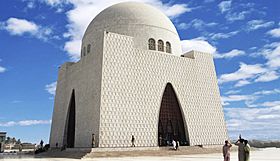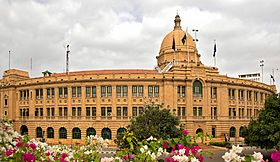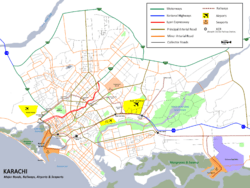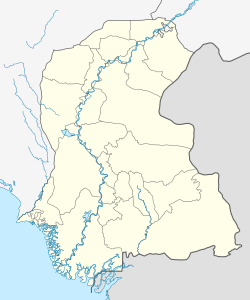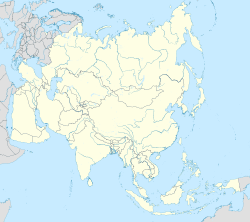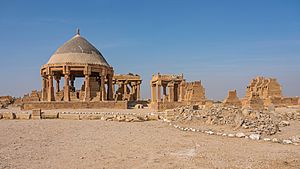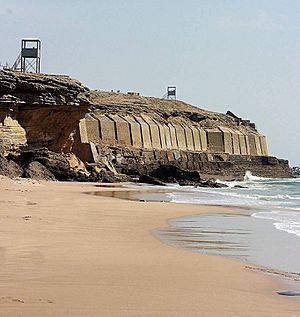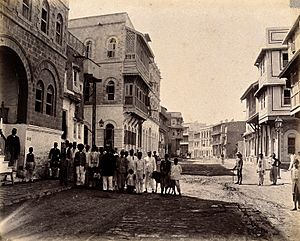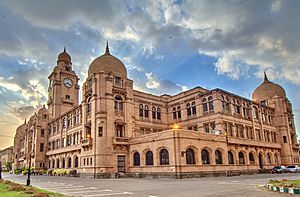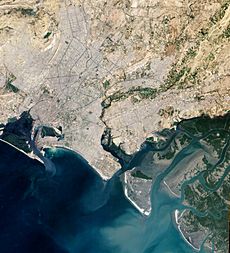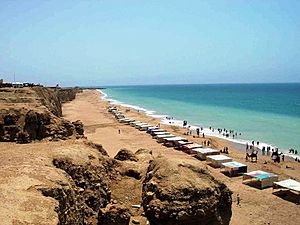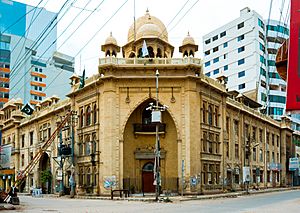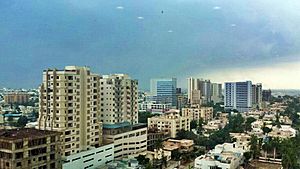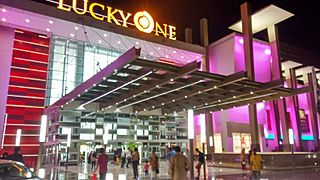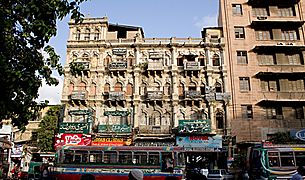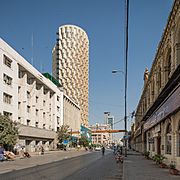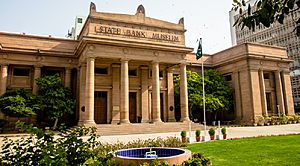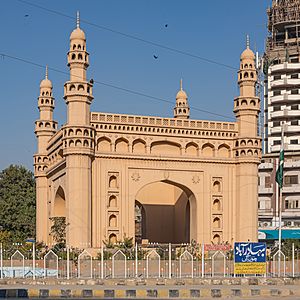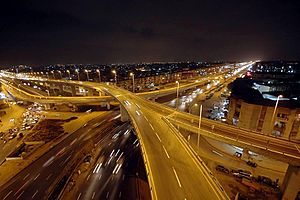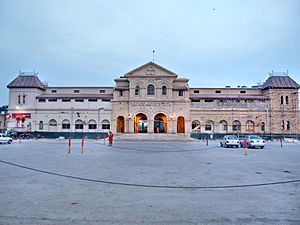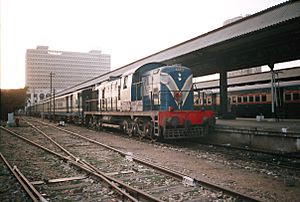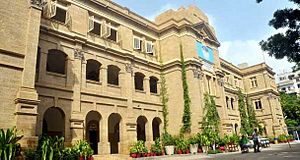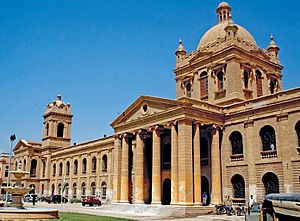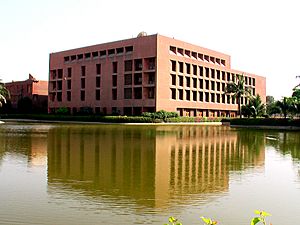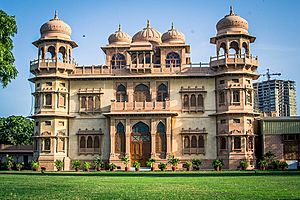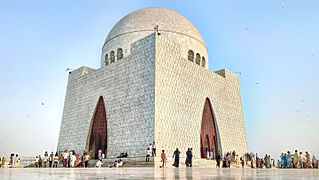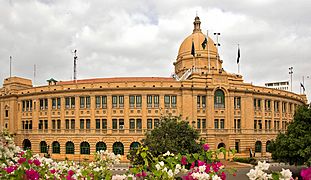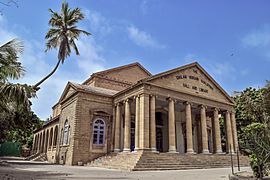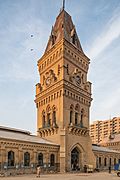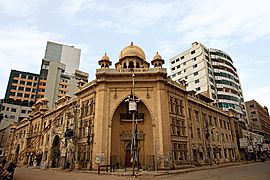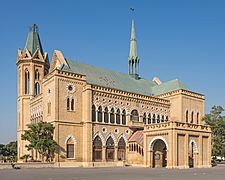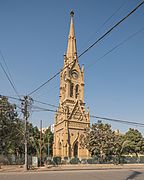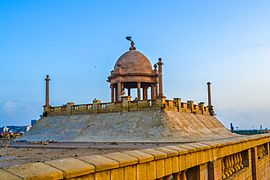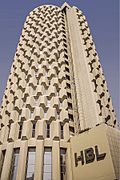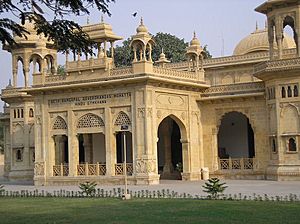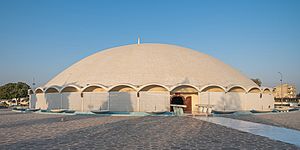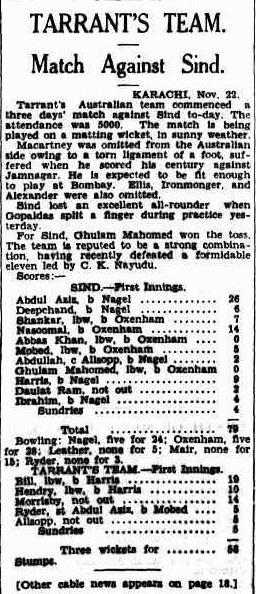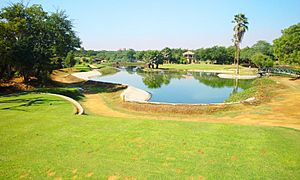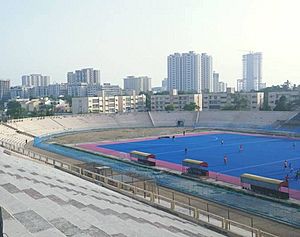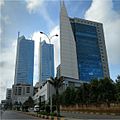Karachi facts for kids
Quick facts for kids
Karachi
کراچی
|
|
|---|---|
|
Clockwise from top:
Mazar-e-Quaid, Hawke's Bay Beach, Frere Hall, Karachi Port Trust Building, Mohatta Palace, Port of Karachi |
|
| Nickname(s):
City of the Quaid, Paris of Asia, The City of Lights, Bride of the Cities
|
|
| Country | |
| Province | |
| Division | Karachi |
| Metropolitan council | 1880 |
| City council | City Complex, Gulshan-e-Iqbal Town |
| Districts |
7
|
| Government | |
| • Type | Metropolitan Corporation |
| • Body | Government of Karachi |
| Area | |
| • City | 3,780 km2 (1,460 sq mi) |
| Elevation | 10 m (30 ft) |
| Population
(2017)
|
|
| • City | 14,910,352 |
| • Rank |
|
| • Density | 3,945/km2 (10,216/sq mi) |
| • Metro | 16,051,521 |
| Demonym(s) | Karachiite |
| Time zone | UTC+05:00 (PST) |
| Postal codes |
74XXX – 75XXX
|
| Dialing code | +9221-XXXX XXX |
| GDP/PPP | $114 billion (2014) |
Karachi is the largest city and former capital of Pakistan and the capital of the province of Sindh. It's old name found in history books is "Mai Kolachi Jo Goth" and "Karatishi" is also one of the old version of its name. A native of Karachi is called a Karachiite. The city is the financial and commercial centre of Pakistan. It has two important regional seaports. The city lies on the coast of the Arabian Sea west of the Indus River delta. Karachi generates the largest share of Pakistan's GDP and national revenue. The population is estimated at approximately 12 million, making it the third largest cities in the world after Shanghai and Mumbai.It has five districts: District South, District East, District West, District Central, and Distrct Malir. Karachi has the most number of districts in Sindh after Hyderabad, which has six districts. Quad-e-Azam (Muhammad Ali Jinnah) father of the nation was born and buried in Karachi.
Apart from the University of Karachi, there are several other institutions of higher education and numerous colleges and schools in Karachi. Karachi is home to the National Stadium which hosts many cricket games, and several other sports complexes. The city has several long sandy beaches including Clifton/Kemari beach and Sandspit beach. Clifton beach suffered from a recent oil spillage but the beach has been cleaned.Karachi has Pakistan's first nuclear site KANUP in 1952 from Canada. The city has 26 universities, including 1. Karachi university-KU 2. Nadirshaw Eduljee Deenshaw engineering university-NED University Hamdard Medical University & 4. Dow University of Health Sciences. Karachi has the honor to host the first ever night hockey match between India and Pakistan in 1986 at Hockey Club of Pakistan Stadium but failed to gain the official status due to having no night hockey match recognition by World Hockey federation at that time.
Karachi has many large and small shopping areas including the Saddar area in downtown Karachi. Karachi also has a number of large modern shopping malls. The city has a modern international airport called the Jinnah International Airport and two large shipping ports at Port of Karachi and Port Qasim. Karachi is linked by railway to the rest of Pakistan.
Contents
History
Early history
The region around Karachi has been the site of human habitation for millennia. Upper Paleolithic and Mesolithic sites have been excavated in the Mulri Hills along Karachi's northern outskirts. These earliest inhabitants are believed to have been hunter-gatherers, with ancient flint tools discovered at several sites.
The expansive Karachi region is believed to have been known to the ancient Greeks, and may have been the site of Barbarikon, an ancient seaport which was located at the nearby mouth of the Indus River. Karachi may also have been referred to as Ramya in ancient Greek texts.
The ancient site of Krokola, a natural harbor west of the Indus where Alexander the Great sailed his a fleet for Achaemenid Assyria, may have been located near the mouth of Karachi's Malir River, though some believe it was located near Gizri. No other natural harbor exists near the mouth of the Indus that could accommodate a large fleet. Nearchus, who commanded Alexander's naval fleet, also mentioned a hilly island by the name of Morontobara and an adjacent flat island named Bibakta, which colonial historians identified as Karachi's Manora Point and Kiamari (or Clifton), respectively, based on Greek descriptions. Both areas were island until well into the colonial era, when silting in led to them being connected to the mainland.
In 711 CE, Muhammad bin Qasim conquered the Sindh and Indus Valley and the port of Debal, from where he launched his forces further into the Indus Valley in 712. Some have identified the port with Karachi, though some argue the location was somewhere between Karachi and the nearby city of Thatta.
Under Mirza Ghazi Beg, the Mughal administrator of Sindh, the development of coastal Sindh and the Indus River Delta was encouraged. Under his rule, fortifications in the region acted as a bulwark against Portuguese incursions into Sindh. In 1553–54, Ottoman admiral Seydi Ali Reis, mentioned a small port along the Sindh coast by the name of Kaurashi which may have been Karachi. The Chaukhandi tombs in Karachi's modern suburbs were built around this time between the 15th and 18th centuries.
Kolachi settlement
19th century Karachi historian Seth Naomal Hotchand recorded that a small settlement of 20–25 huts existed along the Karachi Harbour that was known as Dibro, which was situated along a pool of water known as Kolachi-jo-Kun. In 1725, a band of Balochi settlers from Makran and Kalat had settled in the hamlet after fleeing droughts and tribal feuds.
A new settlement was built in 1729 at the site of Dibro, which came to be known as Kolachi-jo-Goth ("The village of Kolachi"). The new settlement is said to have been named in honour of Mai Kolachi, a resident of the old settlement whose son is said to have slain a man-eating crocodile. Kolachi was about 40 hectares in size, with some smaller fishing villages scattered in its vicinity. The founders of the new fortified settlement were Sindhi Baniyas, and are said to arrived from the nearby town of Kharak Bandar after the harbour there silted in 1728 after heavy rains. Kolachi was fortified, and defended with cannons imported from Muscat, Oman. Under the Talpurs, the Rah-i-Bandar road was built to connect the city's port to the caravan terminals. This road would eventually be further developed by the British into Bandar Road, which was renamed Muhammad Ali Jinnah Road.
The name Karachee was used for the first time in a Dutch document from 1742, in which a merchant ship de Ridderkerk is shipwrecked near the settlement. In 1770s, Karachi came under the control of the Khan of Kalat, which attracted a second wave of Balochi settlers. In 1795, Karachi was annexed by the Talpurs, triggering a third wave of Balochi settlers who arrived from interior Sindh and southern Punjab. The Talpurs built the Manora Fort in 1797, which was used to protect Karachi's Harbor from al-Qasimi pirates.
In 1799 or 1800, the founder of the Talpur dynasty, Mir Fateh Ali Khan, allowed the East India Company under Nathan Crow to establish a trading post in Karachi. He was allowed to build a house for himself in Karachi at that time, but by 1802 was ordered to leave the city. The city continued to be ruled by the Talpurs until it was occupied by forces under the command of John Keane in February 1839.
British control
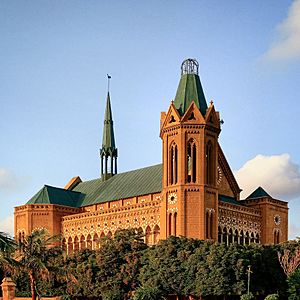
The British East India Company captured Karachi on 3 February 1839 after HMS Wellesley opened fire and quickly destroyed Manora Fort, which guarded Karachi Harbour at Manora Point. Karachi's population at the time was an estimated 8,000 to 14,000, and was confined to the walled city in Mithadar, with suburbs in what is now the Serai Quarter. British troops, known as the "Company Bahadur" established a camp to the east of the captured city, which became the precursor to the modern Karachi Cantonment. The British further developed the Karachi Cantonment as a military garrison to aid the British war effort in the First Anglo-Afghan War.
Sindh's capital was shifted from Hyderabad to Karachi in 1840 until 1843, when Karachi was annexed to the British Empire after Major General Charles James Napier captured the rest of Sindh following his victory against the Talpurs at the Battle of Miani. Following the 1843 annexation, the entire province was amalgamated into the Bombay Presidency for the next 93 years. A few years later in 1846, Karachi suffered a large cholera outbreak, which led to the establishment of the Karachi Cholera Board (predecessor to the city's civic government).
The city grew under the administration of its new Commissioner, Henry Bartle Edward Frere, who was appointed in 1850s. Karachi was recognized for its strategic importance, prompting the British to establish the Port of Karachi in 1854. Karachi rapidly became a transportation hub for British India owing to newly built port and rail infrastructure, as well as the increase in agricultural exports from the opening of productive tracts of newly irrigated land in Punjab and interior Sindh. By 1856, the value of goods traded through Karachi reached ₤855,103, leading to the establishment of merchant offices and warehouses. The population in 1856 is estimated to have been 57,000. During the Sepoy Mutiny of 1857, the 21st Native Infantry, then stationed in Karachi, mutinied and declared allegiance to rebel forces in September 1857, though the British were able to quickly defeat the rebels and reassert control over the city.
Following the Rebellion, British colonial administrators continued to develop the city's infrastructure, but continued to neglect localities like Lyari, which was home to the city's original population of Sindhi fishermen and Balochi nomads. At the outbreak of the American Civil War, Karachi's port became an important cotton-exporting port, with Indus Steam Flotilla and Orient Inland Steam Navigation Company established to transport cotton from interior Sindh to Karachi's port, and onwards to textile mills in England. With increased economic opportunities, economic migrants from several ethnicities and religions, including Anglo-British, Parsis, Marathis, and Goan Christians, among others, established themselves in Karachi, with many setting-up businesses in the new commercial district of Saddar. Muhammad Ali Jinnah, the founder of Pakistan, was born in Karachi's Wazir Mansion in 1876 to such migrants from Gujarat. Public building works were undertaken at this time in Gothic and Indo-Saracenic styles, including the construction of Frere Hall in 1865 and the later Empress Market in 1889.
With the completion of the Suez Canal in 1869, Karachi's position as a major port increased even further. In 1878, the British Raj connected Karachi with the network of British India's vast railway system. In 1887, Karachi Port underwent radical improvements with connection to the railways, along with expansion and dredging of the port, and construction of a breakwater. Karachi's first synagogue was established in 1893. By 1899, Karachi had become the largest wheat-exporting port in the East. In 1901, Karachi's population was 117,000 with a further 109,000 included in the Municipal area.
Under the British, the city's municipal government was established. Known as the Father of Modern Karachi, mayor Seth Harchandrai Vishandas led the municipal government to improve sanitary conditions in the Old City, as well as major infrastructure works in the New Town after his election in 1911. in 1914, Karachi had become the largest wheat-exporting port of the entire British Empire, after large irrigation works in interior Sindh were initiated to increase wheat and cotton yields. By 1924, the Drigh Road Aerodrome was established, now the Faisal Air Force Base.
Karachi's increasing importance as a cosmopolitan transportation hub lead to the influence of non-Sindhis in Sindh's administration. Half the city was born outside of Karachi by as early as 1921. Native Sindhis were upset by this influence, and so 1936, Sindh was re-established as a province separate from the Bombay Presidency with Karachi was once again made capital of Sindh. In 1941, the population of the city had risen to 387,000.
Post-independence
At the dawn of independence following the success of the Pakistan Movement in 1947, Karachi was Sindh's largest city with a population of over 400,000. Partition resulted in the exodus of much of the city's Hindu population, though Karachi, like most of Sindh, remained relatively peaceful compared to cities in Punjab. Riots erupted on 6 January 1948, after which most of Sindh's Hindu population left for India, with assistance of the Indian government.
Karachi became the focus for the resettlement of middle-class Muslim Muhajir refugees who fled India, with 470,000 refugees in Karachi by May 1948, leading to a drastic alteration of the city's demography. In 1941, Muslims were 42% of Karachi's population, but by 1951 made up 96% of the city's population. The city's population had tripled between 1941 and 1951. Urdu replaced Sindhi as Karachi's most widely spoken language; Sindhi was the mother tongue of 51% of Karachi in 1941, but only 8.5% in 1951, while Urdu grew to become the mother tongue of 51% of Karachi's population. 100,000 Muhajir refugees arrived annually in Karachi until 1952.
Karachi was selected as the first capital of Pakistan, and was administered as a federal district separate from Sindh beginning in 1948, until the capital was shifted to Rawalpindi in 1958. While foreign embassies shifted away from Karachi, the city is host to numerous consulates and honorary consulates. Between 1958 and 1970, Karachi's role as capital of Sindh was ceased due to the One Unit programme enacted by President Iskander Mirza.
Karachi of the 1960s was regarded as an economic role model around the world, with Seoul, South Korea, borrowing from the city's second "Five-Year Plan". Several examples of Modernist architect were built in Karachi during this period, including the Mazar-e-Quaid mausoleum, the distinct Masjid-e-Tooba, and the Habib Bank Plaza (the tallest building in all of South Asia at the time). The city's population by 1961 had grown 369% compared to 1941. By the mid 1960s, Karachi began to attract large numbers of Pashtun and Punjabis from northern Pakistan.
The 1970s saw a construction boom funded by remittances and investments from the Gulf States, and the appearance of apartment buildings in the city. Real-estate prices soared during this period, leading to a worsening housing crisis. The period also saw labour unrest in Karachi's industrial estates beginning in 1970 that were violently repressed by the government of President Zulfikar Ali Bhutto from 1972 onwards. To appease conservative forces, Bhutto banned alcohol in Pakistan, and cracked-down of Karachi's discotheques and cabarets - leading to the closure of Karachi's once-lively nightlife. The city's art scene was further repressed during the rule of dictator General Zia-ul-Haq. Zia's Islamization policies lead the Westernized upper-middle classes of Karachi to largely withdraw from the public sphere, and instead form their own social venues that became inaccessible to the poor.
The 1980s and 1990s saw an influx of almost one million Afghan refugees into Karachi fleeing the Soviet–Afghan War; who were in turn followed in smaller numbers by refugees escaping from post-revolution Iran. At this time, Karachi was also rocked by political conflict, while crime rates drastically increased with the arrival of weaponry from the War in Afghanistan. Conflict between the MQM party, and ethnic Sindhis, Pashtuns, and Punjabis was sharp. The party and its vast network of supporters were targeted by Pakistani security forces as part of the controversial Operation Clean-up in 1992 – an effort to restore peace in the city that lasted until 1994. Anti-Hindu riots also broke out in Karachi in 1992 in retaliation for the demolition of the Babri Mosque in India by a group of Hindu nationalists earlier that year.
The 2010s saw another influx of hundreds of thousands of Pashtun refugees fleeing conflict in North-West Pakistan and the 2010 Pakistan floods. By this point Karachi had become widely known for its high rates of violent crime, usually in relation to criminal activity, gang-warfare, sectarian violence, and extrajudicial killings. Recorded crimes sharply decreased following a controversial crackdown operation against criminals, the MQM party, and Islamist militants initiated in 2013 by the Pakistan Rangers. As a result of the operation, Karachi went from being ranked the world's 6th most dangerous city for crime in 2014, to 93rd by early 2020.
Geography
Karachi is located on the coastline of Sindh province in southern Pakistan, along the Karachi Harbour, a natural harbour on the Arabian Sea. Karachi is built on a coastal plain with scattered rocky outcroppings, hills and marshlands. Mangrove forests grow in the brackish waters around the Karachi Harbour, and farther southeast towards the expansive Indus River Delta. West of Karachi city is the Cape Monze, locally known as Ras Muari, which is an area characterised by sea cliffs, rocky sandstone promontories and undeveloped beaches.
Within the city of Karachi are two small ranges: the Khasa Hills and Mulri Hills, which lie in the northwest and act as a barrier between North Nazimabad and Orangi. Karachi's hills are barren and are part of the larger Kirthar Range, and have a maximum elevation of 528 metres (1,732 feet).
Between the hills are wide coastal plains interspersed with dry river beds and water channels. Karachi has developed around the Malir River and Lyari Rivers, with the Lyari shore being the site of the settlement for Kolachi. To the west of Karachi lies the Indus River flood plain.
Climate
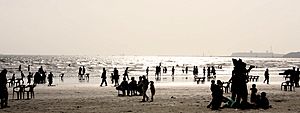
Karachi has a hot desert climate (Köppen: BWh) dominated by a long "Summer Season" while moderated by oceanic influence from the Arabian Sea. The city has low annual average precipitation levels (approx. 250 mm (10 in) per annum), the bulk of which occurs during the July–August monsoon season. While the summers are hot and humid, cool sea breezes typically provide relief during hot summer months, though Karachi is prone to deadly heat waves, though a text message-based early warning system is now in place which helped prevent any fatalities during an unusually strong heatwave in October 2017. The winter climate is dry and lasts between December and February. It is dry and pleasant relative to the warm hot season, which starts in March and lasts until monsoons arrive in June. Proximity to the sea maintains humidity levels at near-constant levels year-round.
The city's highest monthly rainfall, 429.3 mm (16.90 in), occurred in July 1967. The city's highest rainfall in 24 hours occurred on 7 August 1953, when about 278.1 millimetres (10.95 in) of rain lashed the city, resulting in major flooding. Karachi's highest recorded temperature is 48 °C (118 °F) which was recorded on 9 May 1938, and the lowest is 0 °C (32 °F) recorded on 21 January 1934.
Cityscape
The city first developed around the Karachi Harbour, and owes much of its growth to its role as a seaport at the end of the 18th century, contrasted with Pakistan's millennia-old cities such as Lahore, Multan, and Peshawar. Karachi's Mithadar neighbourhood represents the extent of Kolachi prior to British rule.
British Karachi was divided between the "New Town" and the "Old Town", with British investments focused primarily in the New Town. The Old Town was a largely unplanned neighbourhood which housed most of the city's indigenous residents, and had no access to sewerage systems, electricity, and water. The New Town was subdivided into residential, commercial, and military areas. Given the strategic value of the city, the British developed the Karachi Cantonment as a military garrison in the New Town to aid the British war effort in the First Anglo-Afghan War. The city's development was largely confined to the area north of the Chinna Creek prior to independence, although the seaside area of Clifton was also developed as a posh locale under the British, and its large bungalows and estates remain some of the city's most desirable properties. The aforementioned historic areas form the oldest portions of Karachi, and contain its most important monuments and government buildings, with the I. I. Chundrigar Road being home to most of Pakistan's banks, including the Habib Bank Plaza which was Pakistan's tallest building from 1963 until the early 2000s. Situated on a coastal plain northwest of Karachi's historic core lies the sprawling district of Orangi. North of the historic core is the largely middle-class district of Nazimabad, and upper-middle class North Nazimabad, which were developed in the 1950s. To the east of the historic core is the area known as Defence, an expansive upscale suburb developed and administered by the Pakistan Army. Karachi's coastal plains along the Arabian Sea south of Clifton were also developed much later as part of the greater Defence Housing Authority project. Karachi's city limits also include several islands, including Baba and Bhit Islands, Oyster Rocks, and Manora, a former island which is now connected to the mainland by a thin 12-kilometre long shoal known as Sandspit. The city has been described as one divided into sections for those able to afford to live in planned localities with access to urban amenities, and those who live in unplanned communities with inadequate access to such services. Up to 60% of Karachi's residents live in such unplanned communities.
Economy
-
Lucky One Mall is the largest shopping mall in Pakistan as well as in South Asia with an area of about 3.4 million square feet.
Finance and banking
Most of Pakistan's public and private banks are headquartered on Karachi's I. I. Chundrigar Road, which is known as "Pakistan's Wall Street", with a large percentage of the cashflow in the Pakistani economy taking place on I. I. Chundrigar Road. Most major foreign multinational corporations operating in Pakistan have their headquarters in Karachi. Karachi is also home to the Pakistan Stock Exchange, which was rated as Asia's best performing stock market in 2015 on the heels of Pakistan's upgrade to emerging-market status by MSCI.
Media and technology
Karachi has been the pioneer in cable networking in Pakistan with the most sophisticated of the cable networks of any city of Pakistan, and has seen an expansion of information and communications technology and electronic media. The city has become a software outsourcing hub for Pakistan.
Industry
Industry contributes a large portion of Karachi's economy, with the city home to several of Pakistan's largest companies dealing in textiles, cement, steel, heavy machinery, chemicals, and food products. The city is home to approximately 30 percent of Pakistan's manufacturing sector, and produces approximately 42 percent of Pakistan's value added in large scale manufacturing. At least 4500 industrial units form Karachi's formal industrial economy. Karachi's informal manufacturing sector employs far more people than the formal sector, though proxy data suggest that the capital employed and value added from such informal enterprises is far smaller than that of formal sector enterprises. An estimated 63% of the Karachi's workforce is employed in trade and manufacturing.
Karachi Export Processing Zone, SITE, Korangi, Northern Bypass Industrial Zone, Bin Qasim and North Karachi serve as large industrial estates in Karachi. The Karachi Expo Centre also complements Karachi's industrial economy by hosting regional and international exhibitions.
Revenue collection
As home to Pakistan's largest ports and a large portion of its manufacturing base, Karachi contributes a large share of Pakistan's collected tax revenue. As most of Pakistan's large multinational corporations are based in Karachi, income taxes are paid in the city even though income may be generated from other parts of the country. As home to the country's two largest ports, Pakistani customs officials collect the bulk of federal duty and tariffs at Karachi's ports, even if those imports are destined for one of Pakistan's other provinces. Approximately 25% of Pakistan's national revenue is generated in Karachi.
Demographics
Karachi is the most linguistically, ethnically, and religiously diverse city in Pakistan. The city is a melting pot of ethno-linguistic groups from throughout Pakistan, as well as migrants from other parts of Asia. The city's inhabitants are referred to by the demonym Karachiite. The 2017 census numerated Karachi's population to be 14,910,352, having grown 2.49% per year since the 1998 census, which had listed Karachi's population at approximately 9.3 million. The city's inhabitants are referred to by the demonym Karachiite in English, and Karāchīwālā in Urdu.
Population
At the end of the 19th century, Karachi had an estimated population of 105,000. By the dawn of Pakistan's independence in 1947, the city had an estimated population of 400,000. The city's population grew dramatically with the arrival of hundreds of thousands of Muslim refugees from the newly independent Republic of India. Rapid economic growth following independence attracted further migrants from throughout Pakistan and South Asia. The 2017 census numerated Karachi's population to be 14,910,352, having grown 2.49% per year since the 1998 census, which had listed Karachi's population at approximately 9.3 million.
Template:Karachi Historical Population
Ethnicity
The oldest portions of modern Karachi reflect the ethnic composition of the first settlement, with Balochis and Sindhis continuing to make up a large portion of the Lyari neighbourhood, though many of the residents are relatively recent migrants. Following Partition, large numbers of Hindus left Pakistan for the newly independent Dominion of India (later the Republic of India), while a larger percentage of Muslim migrant and refugees from India settled in Karachi. The city grew 150% during the ten period between 1941 and 1951 with the new arrivals from India, who made up 57% of Karachi's population in 1951. The city is now considered a melting pot of Pakistan, and is the country's most diverse city.
In 2011, an estimated 2.5 million foreign migrants lived in the city, mostly from Afghanistan, Bangladesh, Myanmar, and Sri Lanka.
Much of Karachi's citizenry descend from Urdu-speaking migrants and refugees from North India who became known by the Arabic term for "Migrant": Muhajir. The first Muhajirs of Karachi arrived in 1946 in the aftermath of the Great Calcutta Killings and subsequent 1946 Bihar riots. The city's wealthy Hindus opposed the resettlement of refugees near their homes, and so many refugees were accommodated in the older and more congested parts of Karachi. The city witnessed a large influx of Muhajirs following Partition, who were drawn to the port city and newly designated federal capital for its white-collar job opportunities. Muhajirs continued to migrate to Pakistan throughout the 1950s and early 1960s, with Karachi remaining the primary destination of Indian Muslim migrants throughout those decades. The Muhajir Urdu-speaking community in the 2017 census forms slightly less than 45% of the city's population. Muhajirs form the bulk of Karachi's middle class. Muhajirs are regarded as the city's most secular community, while other minorities such as Christians and Hindus increasingly regard themselves as part of the Muhajir community.
Karachi is home to a wide array of non-Urdu speaking Muslim peoples from what is now the Republic of India. The city has a sizable community of Gujarati, Marathi, Konkani-speaking refugees. Karachi is also home to a several-thousand member strong community of Malabari Muslims from Kerala in South India. These ethno-linguistic groups are being assimilated in the Urdu-speaking community.
During the period of rapid economic growth in the 1960s, large numbers Pashtuns from the NWFP migrated to Karachi with Afghan Pashtun refugees settling in Karachi during the 80's. By some estimates, Karachi is home to the world's largest urban Pashtun population, with more Pashtun citizens than the FATA. While generally considered to be one of Karachi's most conservative communities, Pashtuns in Karachi generally vote for the secular Awami National Party rather than religious parties. Pashtuns from Afghanistan are regarded as the most conservative community. Pashtuns from Pakistan's Swat Valley, in contrast, are generally seen as more liberal in social outlook. The Pashtun community forms the bulk of manual labourers and transporters.
Migrants from Punjab began settling in Karachi in large numbers in the 1960s, and now make up an estimated 14% of Karachi's population. The community forms the bulk of the city's police force, and also form a large portion of Karachi's entrepreneurial classes and direct a larger portion of Karachi's service-sector economy. The bulk of Karachi's Christian community, which makes up 2.5% of the city's population, is Punjabi.
Despite being the capital of Sindh province, only 6–8% of the city is Sindhi. Sindhis form much of the municipal and provincial bureaucracy. 4% of Karachi's population speaks Balochi as its mother tongue, though most Baloch speakers are of Sheedi heritage – a community that traces its roots to Africa.
Following the Indo-Pakistani War of 1971 and independence of Bangladesh, thousands of Urdu-speaking Biharis arrived in the city, preferring to remain Pakistani rather than live in the newly independent country. Large numbers of Bengalis also migrated from Bangladesh to Karachi during periods of economic growth in the 1980s and 1990s. Karachi is now home to an estimated 2.5 to 3 million ethnic Bengalis living in Pakistan. Rohingya refugees from Myanmar, who speak a dialect of Bengali and are sometimes regarded as Bengalis, also live in the city. Karachi is home to an estimated 400,000 Rohingya residents. Large scale Rohingya migration to Karachi made Karachi one of the largest population centres of Rohingyas in the world outside of Myanmar.
Central Asian migrants from Uzbekistan and Kyrghyzstan have also settled in the city. Domestic workers from the Philippines are employed in Karachi's posh locales, while many of the city's teachers hail from Sri Lanka. Expatriates from China began migrating to Karachi in the 1940s, to work as dentists, chefs and shoemakers, while many of their decedents continue to live in Pakistan. The city is also home to a small number of British and American expatriates.
During World War II, about 3,000 Polish refugees from the Soviet Union, with some Polish families who chose to remain in the city after Partition. Post-Partition Karachi also once had a sizable refugee community from post-revolutionary Iran.
Religion
| Religions in Karachi | ||||
|---|---|---|---|---|
| Religions | Percent | |||
| Islam | 96.5% | |||
| Christianity | 2.49% | |||
| Hinduism | 0.86% | |||
| Others | 0.4% | |||
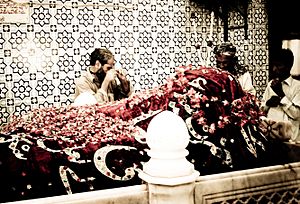
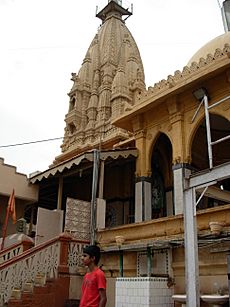
Karachi is one of Pakistan's most religiously diverse cities. Karachiites adhere to numerous sects and sub-sects of Islam, as well as Protestant Christianity, and community of Goan Catholics. The city also is home to large numbers of Hindus, and a small community of Zoroastrians. According to Nichola Khan Karachi is also the world's largest Muslim city.
Prior to Pakistan's independence in 1947, the population of the city was estimated to be 50% Muslim, 40% Hindu, with the remaining 10% primarily Christians (both British and native), with a small numbers of Jews. Following the independence of Pakistan, much of Karachi's Sindhi Hindu population left for India while Muslim refugees from India in turn settled in the city. The city continued to attract migrants from throughout Pakistan, who were overwhelmingly Muslim, and city's population nearly doubled again in the 1950s. As a result of continued migration, over 96.5% of the city currently is estimated to be Muslim.
Karachi is overwhelmingly Muslim, though the city is one of Pakistan's most secular cities. Approximately 85% of Karachi's Muslims are Sunnis, while 15% are Shi'ites. Sunnis primarily follow the Hanafi school of jurisprudence, with Sufism influencing religious practices by encouraging reverence for Sufi saints such as Abdullah Shah Ghazi and Mewa Shah. Shi'ites are predominantly Twelver, with a significant Ismaili minority which is further subdivided into Nizaris, Mustaalis, Dawoodi Bohras, and Sulaymanis.
Approximately 2.5% of Karachi's population is Christian.
Language
Karachi has the largest number of Urdu speakers in Pakistan. As per the 1998 census, the linguistic breakdown of Karachi Division is:
| Rank | Language | 1998 census | Speakers | 1981 census | Speakers |
|---|---|---|---|---|---|
| 1 | Urdu | 48.52% | 4,497,747 | 54.34% | 2,830,098 |
| 2 | Punjabi | 13.94% | 1,292,335 | 13.64% | 710,389 |
| 3 | Pashto | 11.42% | 1,058,650 | 8.71% | 453,628 |
| 4 | Sindhi | 7.22% | 669,340 | 6.29% | 327,591 |
| 5 | Balochi | 4.34% | 402,386 | 4.39% | 228,636 |
| 6 | Saraiki | 2.11% | 195,681 | 0.35% | 18,228 |
| 7 | Others | 12.44% | 1,153,126 | 12.27% | 639,560 |
| All | 100% | 9,269,265 | 100% | 5,208,132 |
The category of "others" includes Gujarati, Dawoodi Bohra, Memon, Marwari, Dari, Brahui, Makrani, Hazara, Khowar, Gilgiti, Burushaski, Balti, Arabic, Farsi and Bengali. The number of Sindhi speakers in Karachi is growing as many are moving from rural areas to the city.
Transportation
Road
Karachi is served by a road network estimated to be approximately 9,500 kilometres (5,900 miles) in length, serving approximately 3.1 million vehicles per day.
Rail
Karachi is linked by rail to the rest of the country by Pakistan Railways. The Karachi City Station and Karachi Cantonment Railway Station are the city's two major railway stations. The city has an international rail link, the Thar Express which links Karachi Cantonment Station with Bhagat Ki Kothi station in Jodhpur, India.
The railway system also handles freight linking Karachi port to destinations up-country in northern Pakistan.
Public transport
Karachi's public transport infrastructure is inadequate and constrained by low levels of investment. Karachi is not currently served by any municipal public transit, and is instead serviced primarily by the private and informal sector.
Karachi Circular Railway
Karachi was once served by the Karachi Circular Railway that was started in 1969 and closed in 1999. A tramway service was started in 1884 in Karachi but was closed in 1975 because of some reasons. While the Japanese Government has expressed willingness to help fund the refurbishment of the Karachi Circular Railway, the project has not been finalized. In March 2020, Minister of Railways Sheikh Rasheed Ahmed said that the Karachi Circular Railway "will be operationalized in six months" in collaboration with the government of Sindh. In the budget of fiscal year 2020–21, Rs1,500 million has been allocated for the operationalisation of train on existing KCR alignment. In the budget of fiscal year 2020–21, Sindh Government enmarked Rs207 billion for the revival of KCR.
Air

Karachi's Jinnah International Airport is the busiest airport of Pakistan with a total of 7.2 million passengers in 2018. The current terminal structure was built in 1992, and is divided into international and domestic sections. Karachi's airport serves as a hub for the flag carrier, Pakistan International Airlines (PIA), as well as for Air Indus, Serene Air and airblue. The airport offers non-stop flights to destinations throughout East Asia, South Asia, Southeast Asia, the Persian Gulf States, Europe and North America.
Sea
The largest shipping ports in Pakistan are the Port of Karachi and the nearby Port Qasim, the former being the oldest port of Pakistan. Port Qasim is located 35 kilometres (22 miles) east of the Port of Karachi on the Indus River estuary. These ports handle 95% of Pakistan's trade cargo to and from foreign ports. These seaports have modern facilities which include bulk handling, containers and oil terminals.
Education
Primary and secondary
Karachi's primary education system is divided into five levels: primary (grades one through five); middle (grades six through eight); high (grades nine and ten, leading to the Secondary School Certificate); intermediate (grades eleven and twelve, leading to a Higher Secondary School Certificate); and university programs leading to graduate and advanced degrees. Karachi has both public and private educational institutions. Most educational institutions are gender-based, from primary to university level alongside the co education institutions.
Several of Karachi's schools, such as St Patrick's High School, St Joseph's Convent School and St Paul's English High School, are operated by Christian churches, and among Pakistan's most prestigious schools.
Higher
Karachi is home to several major public universities. Karachi's first public university's date from the British colonial era. The Sindh Madressatul Islam founded in 1885, was granted university status in 2012. Establishment of the Sindh Madressatul Islam was followed by the establishment of the D. J. Sindh Government Science College in 1887, and the institution was granted university status in 2014. The Nadirshaw Edulji Dinshaw University of Engineering and Technology (NED), was founded in 1921, and is Pakistan's oldest institution of higher learning. The Dow University of Health Sciences was established in 1945, and is now one of Pakistan's top medical research institutions.
The University of Karachi, founded in 1951, is Pakistan's largest university with a student population of 24,000. The Institute of Business Administration (IBA), founded in 1955, is the oldest business school outside of North America and Europe, and was set up with technical support from the Wharton School and the University of Southern California. The Dawood University of Engineering and Technology, which opened in 1962, offers degree programmes in petroleum, gas, chemical, and industrial engineering. The Pakistan Navy Engineering College (PNEC), operated by the Pakistan Navy, is associated with the National University of Sciences and Technology (NUST) in Islamabad.
Karachi is also home to numerous private universities. The Aga Khan University, founded in 1983, is Karachi's oldest private educational institution, and is one of Pakistan's most prestigious medical schools. The Indus Valley School of Art and Architecture was founded in 1989, and offers degree programmes in arts and architectural fields. Hamdard University is the largest private university in Pakistan with faculties including Eastern Medicine, Medical, Engineering, Pharmacy, and Law. The National University of Computer and Emerging Sciences (NUCES-FAST), one of Pakistan's top universities in computer education, operates two campuses in Karachi. Bahria University (BU) founded in 2000, is one of the major general institutions of Pakistan with their campuses in Karachi, Islamabad and Lahore offers degree programs in Management Sciences, Electrical Engineering, Computer Science and Psychology. Sir Syed University of Engineering and Technology (SSUET) offers degree programmes in biomedical, electronics, telecom and computer engineering. Karachi Institute of Economics & Technology (KIET) has two campuses in Karachi. The Shaheed Zulfiqar Ali Bhutto Institute of Science and Technology (SZABIST), founded in 1995 by former Prime Minister Benazir Bhutto, operates a campus in Karachi.
- Iqra University
- Habib University
 Habib University is a liberal arts college in Karachi.
Habib University is a liberal arts college in Karachi. - Dow University
- Jinnah Medical and Dental College
- Jinnah Sindh Medical University
- Karachi Institute of Economics and Technology
- United Medical and Dental College
- Liaquat National Medical College
- Institute of Cost & Management Accountants of Pakistan (ICMAP)
- Institute of Business Management (CBM)
Healthcare
Karachi is a centre of research in biomedicine with at least 30 public hospitals, 80 registered private hospitals and 12 recognized medical colleges.
Karachi municipal authorities in October 2017 launched a new early warning system that alerted city residents to a forecasted heatwave. Previous heatwaves had routinely claimed lives in the city, but implementation of the warning system was credited for no reported heat-related fatalities.
Entertainment, arts and culture
Entertainment and shopping malls
Karachi is home to Pakistan and South Asia's largest shopping mall, Lucky One Mall which hosts more than two hundred stores. According to TripAdvisor the city is also home to Pakistan's favorite shopping mall, Dolmen Mall, Clifton which was also featured on CNN and the country's favorite entertainment complex, Port Grand. In 2019 the city is expected to add another mega mall/entertainment complex at Bahria Icon Tower Clifton, Pakistan's tallest skyscraper.
Museums and galleries
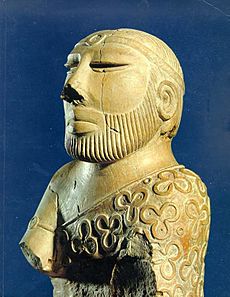
Karachi is home to several of Pakistan's most important museums. The National Museum of Pakistan and Mohatta Palace display artwork, while the city also has several private art galleries. The city is also home to the Pakistan Airforce Museum and Pakistan Maritime Museum are also located in the city. Wazir Mansion, the birthplace of Pakistan's founder Muhammad Ali Jinnah has also been preserved as a museum open to the public.
Theatre and Cinema
Karachi is home to some of Pakistan's important cultural institutions. The National Academy of Performing Arts, located in the former Hindu Gymkhana, offers diploma courses in performing arts including classical music and contemporary theatre. Karachi is home to groups such as Thespianz Theater, a professional youth-based, non-profit performing arts group, which works on theatre and arts activities in Pakistan.
Though Lahore is considered to be home of Pakistan's film industry, Karachi is home to Kara Film Festival annually showcases independent Pakistani and international films and documentaries.
Music
The All Pakistan Music Conference, linked to the 45-year-old similar institution in Lahore, has been holding its annual music festival since its inception in 2004. The National Arts Council (Koocha-e-Saqafat) has musical performances and mushaira.
Tourist attractions
Karachi is a tourist destination for domestic and international tourists. Tourist attractions near Karachi city include:
Museums: Museums located in Karachi include the National Museum of Pakistan, Pakistan Air Force Museum, and Pakistan Maritime Museum.
Parks: Parks located in Karachi include Bagh Ibne Qasim, Boat Basin Park, Mazar-e-Quaid, Karachi Zoo, Hill Park, Safari Park, Bagh-e-Jinnah, PAF Museum Park and Maritime Museum Park.
Architecture
Karachi has a collection of buildings and structures of varied architectural styles. The downtown districts of Saddar and Clifton contain early 20th-century architecture, ranging in style from the neo-classical KPT building to the Sindh High Court Building. Karachi acquired its first neo-Gothic or Indo-Gothic buildings when Frere Hall, Empress Market and St. Patrick's Cathedral were completed. The Mock Tudor architectural style was introduced in the Karachi Gymkhana and the Boat Club. Neo-Renaissance architecture was popular in the 19th century and was the architectural style for St. Joseph's Convent (1870) and the Sind Club (1883). The classical style made a comeback in the late 19th century, as seen in Lady Dufferin Hospital (1898) and the Cantt. Railway Station. While Italianate buildings remained popular, an eclectic blend termed Indo-Saracenic or Anglo-Mughal began to emerge in some locations. The local mercantile community began acquiring impressive structures. Zaibunnisa Street in the Saddar area (known as Elphinstone Street in British days) is an example where the mercantile groups adopted the Italianate and Indo-Saracenic style to demonstrate their familiarity with Western culture and their own. The Hindu Gymkhana (1925) and Mohatta Palace are examples of Mughal revival buildings. The Sindh Wildlife Conservation Building, located in Saddar, served as a Freemasonic Lodge until it was taken over by the government. There are talks of it being taken away from this custody and being renovated and the Lodge being preserved with its original woodwork and ornate wooden staircase.
Indus Valley School of Art and Architecture is one of the prime examples of Architectural conservation and restoration where an entire Nusserwanjee building from Kharadar area of Karachi has been relocated to Clifton for adaptive reuse in an art school. The procedure involved the careful removal of each piece of timber and stone, stacked temporarily, loaded on the trucks for transportation to the Clifton site, unloaded and re-arranged according to a given layout, stone by stone, piece by piece, and completed within three months.
Architecturally distinctive, even eccentric, buildings have sprung up throughout Karachi. Notable example of contemporary architecture include the Pakistan State Oil Headquarters building. The city has examples of modern Islamic architecture, including the Aga Khan University hospital, Masjid e Tooba, Faran Mosque, Bait-ul Mukarram Mosque, Quaid's Mausoleum, and the Textile Institute of Pakistan. One of the unique cultural elements of Karachi is that the residences, which are two- or three-story townhouses, are built with the front yard protected by a high brick wall. I. I. Chundrigar Road features a range of extremely tall buildings. The most prominent examples include the Habib Bank Plaza, PRC Towers and the MCB Tower which is the tallest skyscraper in Pakistan.
Sports
When it comes to sports Karachi has a distinction, because some sources cite that it was in 1877 at Karachi in (British) India, where the first attempt was made to form a set of rules of badminton and likely place is said to Frere Hall.
Cricket's history in Pakistan predates the creation of the country in 1947. The first ever international cricket match in Karachi was held on 22 November 1935 between Sindh and Australian cricket teams. The match was seen by 5,000 Karachiites. Karachi is also the place that innovated tape ball, a safer and more affordable alternative to cricket.
The inaugural first-class match at the National Stadium was played between Pakistan and India on 26 February 1955 and since then Pakistani national cricket team has won 20 of the 41 Test matches played at the National Stadium. The first One Day International at the National Stadium was against the West Indies on 21 November 1980, with the match going to the last ball.
The national team has been less successful in such limited-overs matches at the ground, including a five-year stint between 1996 and 2001, when they failed to win any matches. The city has been host to a number of domestic cricket teams including Karachi, Karachi Blues, Karachi Greens, and Karachi Whites. The National Stadium hosted two group matches (Pakistan v. South Africa on 29 February and Pakistan v. England on 3 March), and a quarter-final match (South Africa v. West Indies on 11 March) during the 1996 Cricket World Cup.
The city has hosted seven editions of the National Games of Pakistan, most recently in 2007.
In 2005, the city hosted the SAFF Championship at this ground, as well as the Geo Super Football League 2007, which attracted capacity crowds during the games. The popularity of golf is increasing, with clubs in Karachi like Dreamworld Resort, Hotel & Golf Club, Arabian Sea Country Club, DA Country & Golf Club. The city has facilities for field hockey (the Hockey Club of Pakistan, UBL Hockey Ground), boxing (KPT Sports Complex), squash (Jahangir Khan Squash Complex), and polo. There are marinas and boating clubs. National Bank of Pakistan Sports Complex is First-class cricket venue and Multi-purpose sports facility in Karachi,
- Professional Karachi teams
| Club | League | Sport | Venue | Established |
|---|---|---|---|---|
| Karachi Kings | Pakistan Super League | Cricket | National Stadium | 2015 |
| Karachi Dolphins | National T20 League/National One-day Championship | Cricket | National Stadium | 2004 |
| Karachi Zebras | National T20 League/National One-day Championship | Cricket | National Stadium | 2004 |
| HBL FC | Pakistan Premier League | Football | Peoples Football Stadium | 1975 |
| K-Electric F.C. | Pakistan Premier League | Football | Peoples Football Stadium | 1913 |
| KPT F.C. | Pakistan Premier League | Football | KPT Football Stadium | 1887 |
| NBP F.C. | Pakistan Premier League | Football | KPT Football Stadium | N/A |
| PIA F.C. | Pakistan Premier League | Football | KPT Football Stadium | 1958 |
Other pages
Images for kids
-
Lord Mountbatten and his wife Edwina in Karachi 14 August 1947
-
Abdullah Shah Ghazi, an 8th Century Sufi mystic, is the patron saint of Karachi.
-
Karachi's Jinnah International Airport is the busiest and second largest airport in Pakistan.
-
The former US Embassy, designed by modernist architect Richard Neutra
See also
 In Spanish: Karachi para niños
In Spanish: Karachi para niños


